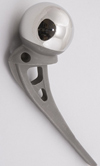Ion implantation
 It cannot be lost on anyone reading the articles I have written that an understanding or at least appreciation of residual stresses in engine parts can lead to improved component life or to the development of lighter parts. The book by Almen and Black, "Residual Stress and Fatigue in Metals", is worth reading, if you can get hold of a copy.
It cannot be lost on anyone reading the articles I have written that an understanding or at least appreciation of residual stresses in engine parts can lead to improved component life or to the development of lighter parts. The book by Almen and Black, "Residual Stress and Fatigue in Metals", is worth reading, if you can get hold of a copy.
There are a number of ways to impart beneficial residual stresses, and many of these have been discussed in the pages of Race Engine Technology magazine and here on RET-Monitor. There are surface hardening treatments such as nitriding and carburising, and mechanical processes such as shot-peening and fillet-rolling that can be used to impart these stresses in critical areas.
In some ways, ion implantation is similar to the surface hardening processes, in that it seeks to implant elements into the surface of components, thereby imparting compressive stresses and changing the composition of the surface. While not a temperature-controlled diffusion process, it is possible to implant a wide range of ions into the surface of a given component, and the range of materials to which the process can be applied is also very diverse - to ceramics and polymers, as well as metals.
The ions are implanted into the surface due to the kinetic energy of the ion beam. There is some heating of the surface due to the energy of the ions bombarding the surface. The same equipment used for ion implantation may be also used to apply PVD coatings. High Power Impulse Magnetron Sputtering (HIPIMS) is an example of a process which can be used for ion implantation and coating.
In terms of metallic components, the most common processes, where steel components are concerned, implant nitrogen ions into the surface to a far shallower depth than is common with nitriding or nitrocarburising treatments. In fact the depth to which the ions are implanted is often less than 0.5 microns (0.00002 in).
These ions form nitrides in the immediate surface layer of the component, giving a hard and wear-resistant surface. Nitrogen ions can also be implanted into the surface of high-temperature alloys to improve wear resistance, as well as into titanium, to form a thin layer of finely dispersed titanium nitride, combined with compressive residual stresses.
It is also possible to implant other ions such as chromium, titanium and boron into the surface of steel components, forming compounds within the surface layers of components based on elements not present within the base material composition. For instance, it is possible to form titanium boride (TiB2) within the surface layer of steel components, and chromium ions can be implanted into steels to improve corrosion resistance.
Titanium ions implanted into the surface of an aluminium alloy have been shown to form surface layers of titanium aluminide. Further studies have shown that implanting nitrogen ions into aluminium form aluminium nitride. The result is dramatically improved frictional behaviour and improved resistance to oxidation.
By using inert gases - argon, for example - the same process of bombarding coated components can improve adhesion by 'knocking' part of the coating into the substrate, in a process known as ion mixing. The process has also been shown to improve the tribological behaviour of polymers.
Fig. 1 - Ion implantation is widely used in other areas of engineering to improve wear behaviour. This is a replacement hip joint
Written by Wayne Ward